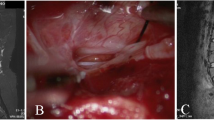Abstract
We assess the theoretical feasibility of percutaneous posterior sacral foramen (pSF) needle puncture of the sacral dural sac (DS) by studying the three-dimensional imaging anatomy of pSFs relative to the sacral canal (SC). On CT images of 40 healthy subjects, we retrospectively studied sacral alae passageways from SC to pSFs in all three planes to determine if an imaginary spinal needle could theoretically traverse S1 or S2 pSFs in a straight path toward DS. If not straight, we measured multiplane angulations and morphometrics of this route. We found no straight connections between S1 or S2 pSFs and SC. Instead, there were bilateral spatially complex dorsoventral M-shaped “foraminal conduits” (FCs; common, ventral, and dorsal) from SC to anterior SFs and pSFs that would prevent percutaneous straight needle puncture of the DS. This detailed knowledge of the sacral FCs will be useful for accurate imaging interpretation and interventional procedures on the sacrum.


Similar content being viewed by others
Data Availability
Data generated or analyzed during the study are available from the corresponding author upon reasonable request.
References
Hudgins PA, Fountain AJ, Chapman PR, Shah LM (2017) Difficult lumbar puncture: pitfalls and tips from the trenches. AJNR Am J Neuroradiol 38:1276–1283. https://doi.org/10.3174/ajnr.A5128
Nascene DR, Ozutemiz C, Estby H, McKinney AM, Rykken JB (2018) Transforaminal lumbar puncture: an alternative technique in patients with challenging access. AJNR Am J Neuroradiol 39:986–991. https://doi.org/10.3174/ajnr.A5596
Sujay M, Madhavi S, Aravind G, Hasan A, Venugopalan VM (2014) Transforaminal sacral approach for spinal anesthesia in orthopedic surgery: a novel approach. Anesth Essays Res 8:253–255. https://doi.org/10.4103/0259-1162.134526
Paria R, Surroy S, Majumder M, Paria B, Paria A, Das G (2014) Sacral spinal anaesthesia. Indian J Anaesth 58:80–82. https://doi.org/10.4103/0019-5049.126809
Whelan MA, Gold RP (1982) Computed tomography of the sacrum: 1. normal anatomy. AJR Am J Roentgenol 139:1183–1190. https://doi.org/10.2214/ajr.139.6.1183
Jackson H, Burke JT (1984) The sacral foramina. Skeletal Radiol 11:282–288. https://doi.org/10.1007/BF00351354
Trinh A, Hashmi SS, Massoud TF (2021) Imaging anatomy of the vertebral canal for trans-sacral hiatus puncture of the lumbar cistern. Clin Anat 34:348–356. https://doi.org/10.1002/ca.23612
Dhawan SS, Trinh A, Massoud TF (2023) Feasibility of intrathecal therapeutic injections in spinal muscular atrophy patients via a percutaneous transsacral hiatus route: an initial neuroimaging morphometric study. Muscle Nerve 67:226–230. https://doi.org/10.1002/mus.27782
Baker M, Wilson M, Wallach S (2018) Urogenital symptoms in women with Tarlov cysts. J Obstet Gynaecol Res 44:1817–1823. https://doi.org/10.1111/jog.13711
Liguoro D, Viejo-Fuertes D, Midy D, Guerin J (1999) The posterior sacral foramina: an anatomical study. J Anat 195:301–304. https://doi.org/10.1046/j.1469-7580.1999.19520301.x
Acknowledgements
None.
Funding
The authors did not receive support from any organization for the submitted work. No funding was received to assist with the preparation of this manuscript. No funding was received for conducting this study. No funds, grants, or other support was received.
Author information
Authors and Affiliations
Contributions
All authors contributed to the study conception and design. Material preparation, data collection, and analysis were performed by Siddhant S. Dhawan, Fabian N. Necker, and Tarik F. Massoud. The first draft of the manuscript was written by Siddhant S. Dhawan and Tarik F. Massoud and all authors commented on previous versions of the manuscript. All authors read and approved the final manuscript.
Corresponding author
Ethics declarations
Ethics approval
We obtained ethical approval for this research study and waiver of individual patient consent from our local institutional review board administrative panel on human subjects in medical research. This approval was obtained from the ethics committee of Stanford University School of Medicine, USA (protocol: 55014). The procedures used in this study adhere to the tenets of the Declaration of Helsinki.
Consent to participate and publish
This retrospective chart review study involving human participants was in accordance with the ethical standards of the institutional and national research.committee and with the 1964 Helsinki Declaration and its later amendments or comparable ethical standards. The Human Investigation Committee (IRB) of Stanford University School of Medicine, USA, approved this study (protocol: 55014). This included waiver of individual authorization for recruitment under title 45 CFR 164.512, pursuant to information provided in the HIPAA section of the protocol application. Consent was not required as patient information was anonymized and the publication submission does not include images that may identify the patient.
Competing interests
The authors have no relevant financial or non-financial interests to disclose. The authors have no competing interests to declare that are relevant to the content of this article. All authors certify that they have no affiliations with or involvement in any organization or entity with any financial interest or non-financial interest in the subject matter or materials discussed in this manuscript. The authors have no financial or proprietary interests in any material discussed in this article.
Additional information
Publisher's note
Springer Nature remains neutral with regard to jurisdictional claims in published maps and institutional affiliations.
Supplementary information
Below is the link to the electronic supplementary material.
Supplementary file2 (MOV 45208 KB)
Rights and permissions
Springer Nature or its licensor (e.g. a society or other partner) holds exclusive rights to this article under a publishing agreement with the author(s) or other rightsholder(s); author self-archiving of the accepted manuscript version of this article is solely governed by the terms of such publishing agreement and applicable law.
About this article
Cite this article
Dhawan, S.S., Necker, F.N. & Massoud, T.F. Feasibility of percutaneous dural sac puncture via a posterior trans-sacral foraminal conduit approach: a CT morphometric analysis. Neuroradiology 65, 1555–1559 (2023). https://doi.org/10.1007/s00234-023-03147-4
Received:
Accepted:
Published:
Issue Date:
DOI: https://doi.org/10.1007/s00234-023-03147-4




